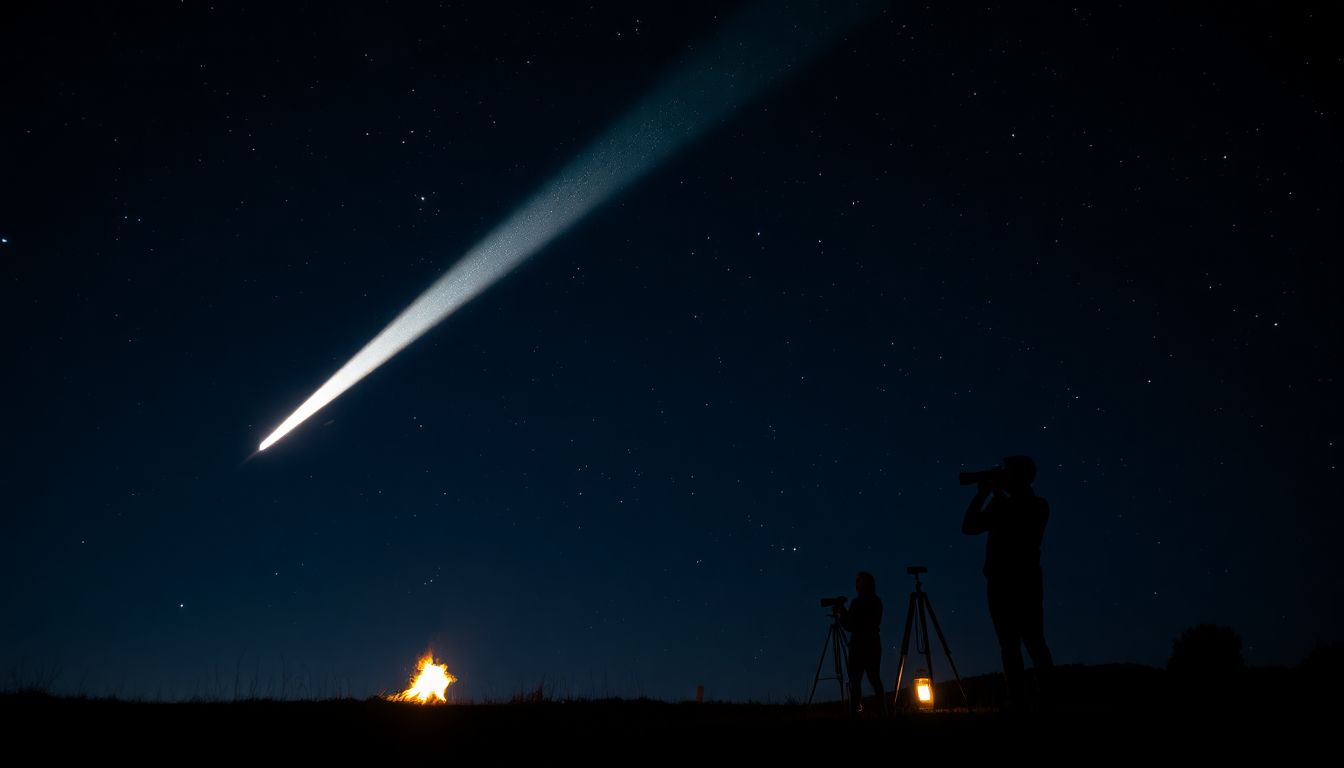
Can I See the Comet Tonight? Simple Steps to Find Out
Introduction
Seeing a comet is a rare and exciting event. It’s like catching a glimpse of a mini spaceship streaking across the sky. Since comets don’t come around often, planning ahead is key. Knowing when and where to look can turn a simple evening into a memorable skywatching adventure. In this guide, you\’ll learn how to check if a comet is visible from your location. We’ll go over tools, tips, and tricks to help you find comets easily. Get ready to become a sky detective and maybe even spot one tonight!
Understanding Comets and Their Visibility
What Are Comets?
Comets are icy visitors from space, traveling through our solar system. They are made of ice, dust, and gas. When they get close to the Sun, they develop a glowing tail. These bright streaks are what make comets special to skywatchers. They move slowly across the sky, sometimes shining brighter than stars.
Why Comets Are Visible to the Naked Eye
Not all comets are easy to see. Brightness depends on how big they are and how close they are to Earth. Some comets, like NEOWISE or Leonard, are clear even without a telescope. Others stay hidden behind clouds or are too faint. When a comet gets close enough, its glow can be seen with just your eyes or binoculars.
Best Times to View Comets
The best times to spot comets change with the seasons. Usually, comets are visible around their closest approach to Earth. The moon\’s phases matter, too—dark nights make comets stand out better. Clear weather and little light pollution are also key to a good sighting. Watch for news about upcoming comets when planning your skywatching night.
Checking the Visibility of Comets in Your Area
Using Online Tools and Apps
Want to know if a comet is visible tonight? Check websites like Sky & Telescope or Heavens-Above. They give current info on what’s up in your night sky. Smartphone apps like Star Walk or Stellarium show real-time positions of comets. Just set your location, and the app will tell you where to look.
Consulting Astronomical Data and Alerts
Space agencies like NASA post updates about comets. Subscribing to newsletters or alerts from your local observatories can keep you informed. They often announce upcoming comets and the best viewing times. These reliable sources make spotting easy.
Considering Local Conditions
Weather plays a big role. Check the forecast for clear skies. Cloud cover can hide even the brightest comets. Also, look at maps showing light pollution. Darker skies away from city lights improve your chances. Find open areas with a clear view of the horizon for the best experience.
Preparing for a Successful Comet Viewing
Choosing the Right Equipment
You don’t need high-tech gear to see a comet. Binoculars are great for beginners and portable. A small telescope can give you a closer look if you want. Even a smartphone camera can capture a comet if you know how to set it up right.
Selecting the Best Viewing Location
Look for a place with minimal light pollution. Parks or rural areas work best. Elevation helps by reducing atmospheric interference. Make sure your view isn’t blocked by trees or buildings. A location with a clear, dark sky is your best bet.
Timing Your Observation
The hours just after sunset or before dawn are ideal. During these times, the sky is dark enough but the comet is still visible. Avoid nights with a bright Moon, which can wash out faint objects. Plan your watch about a couple of hours before or after sunset.
Tips and Best Practices for Spotting the Comet
Step-by-Step Observation Guide
Start by finding familiar constellations like Orion or the Big Dipper. Use star charts or mobile apps to locate the comet’s position. Follow the guide to point your binoculars or telescope at the right spot in the sky. Be patient; comets move slowly but steadily.
Enhancing the Viewing Experience
Keep your eyes on the lookout and check the sky often. Take notes or photos to remember what you saw. Watching for a few nights can increase your chances of catching it. The more you look, the more likely you’ll see something special.
Safety and Comfort Tips
Dress warmly if the night is chilly. Bring water or snacks to stay comfortable. Use red flashlight instead of white light—this keeps your night vision sharp. Sit or lie down comfortably, and enjoy the quiet beauty of the night sky.
Conclusion
To spot a comet tonight, start by checking online tools and apps for visibility updates. Pick a dark, open spot away from city lights. Gather simple equipment like binoculars or a camera. Be patient, follow the stars, and enjoy the experience. Sometimes, all it takes is a little preparation and curiosity to witness a piece of space magic. So, grab your gear and look up—your next sky adventure might just be a glance away.
Key Takeaways
- Use online tools and mobile apps to confirm if a comet is visible in your area tonight.
- Choose the right time—just after sunset or before dawn—for the best chance to see the comet.
- Find a dark spot away from city lights and prepare your equipment early.
- Patience and persistence are your best friends in skywatching.
Happy comet hunting!

